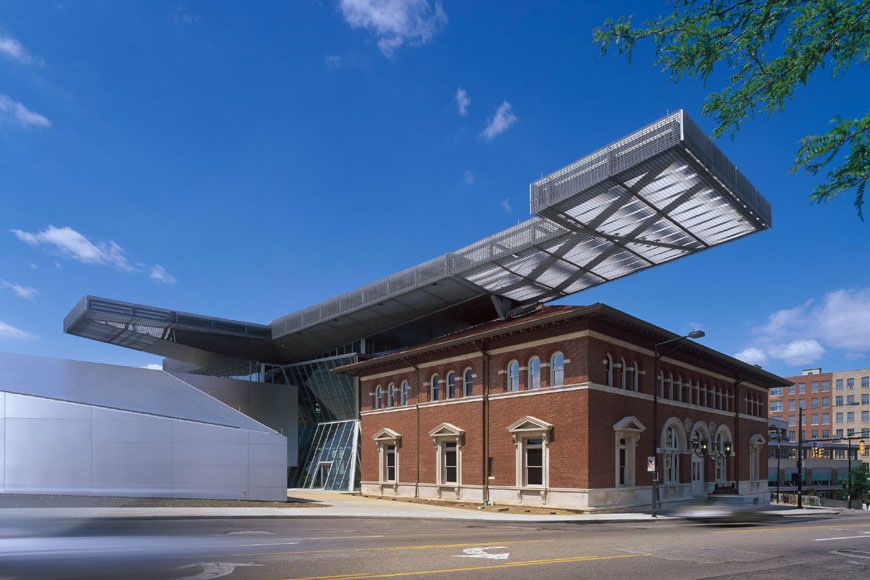The Akron Art Museum is museum of modern and contemporary art in Akron, Ohio, housed in a historical building with an iconic expansion designed by Austrian architectural firm Coop Himmelb(l)au.
History, the old building, and Coop Himmelb(l)au’s expansion
The museum’s origins trace back to 1922 when a small and heterogeneous collection of art aimed at the students of Akron’s art institute was located in the basement of the city’s public library. After World War Two, the museum was redefined as an institution focused on contemporary fine art, and moved into various seats before relocating into its current home, a late-19th-century former post office brick building.
In 2007, the old building was substantially enlarged by an iconic expansion designed by Austrian architectural firm Coop Himmelb(l)au, which increased the museum’s floor area from 2,367 to 8,244 square meters (from 25,478 to 88,738 square feet).
At the same time, an external asphalted area within the museum’s premises was converted into a garden and a multi-functional public outdoor space after a design by Philadelphia-based landscape architects Olin Partners.
Coop Himmelb(l)au’s ambitious design was aimed to create a “museum of the future”, that is not only an exhibition space to display diverse forms of art, but an urban space through which “art should be able to flow out of the building and the city should be able to flow inside”.
The expansion is composed of three main parts.
The Crystal is an imposing daylight-filled entrance lobby and multi-functional space whose functional concept was inspired by that of a large banquet hall.
Located above the entrance, the Gallery Box is a flexible exhibition space, directly connected to the museum’s storage areas by a freight elevator to bring and display large artworks into it. This space is intentionally not provided with natural light, to protect the artworks from potential damage from sunlight.
Finally, the so-called Roof Cloud is a 327-foot-long cantilevered steel structure perched on top of the expansion which is both a landmark and a shading system, and also accommodates interior and exterior spaces with a panoramic view over the city.
Akron Art Museum, conceptual diagram © Coop Himmelb(l)au
View of the museum’s entrance from the west; photo © Roland Halbe; courtesy of Coop Himmelb(l)au.
Collection and program of events
The collection of the Akron Art Museum features fine art from 1850 to the present, including American Impressionism, Abstract art, Minimalism, Pop Art, and African-American art.
The permanent exhibition presents, on a rotational basis, works from the collection – sculptures, installations, paintings, prints, works on paper, and photographs by acclaimed American, Asian, and European artists including Marina Abramovic, Ansel Adams, Diane Arbus, Christo, Chuck Close, Gene Davis, Mark di Suvero, Jim Dine, Jean Dubuffet, Marcel Duchamp, Donald Judd, Yayoi Kusama, Sol LeWitt, René Magritte, Man Ray, Claes Oldenburg, Nam June Paik, Doris Salcedo, Cindy Sherman, Frank Stella, Hiroshi Sugimoto, and Andy Warhol, among others.
The program of events and activities of the museum includes special exhibitions, guided tours, lectures, conferences, children’s programs, creative workshops, and educational activities.
Fully accessible to physically impaired people, the Akron Museum of Art also accommodates an 11,000-volume library, a cafe, and a gift and bookshop.
Images
View of the museum’s building from the west; photo © Roland Halbe
Longitudinal section © Coop Himmelb(l)au
The museum lobby; photo © Roland Halbe courtesy of Coop Himmelb(l)au.
Jimmy Kuehnle, Wiggle, Giggle, Jiggle, 2016, installation view (exterior). Photography by Shane Wynn; courtesy of Akron Art Museum
Cover image, view of the museum from north-east; © Roland Halbe, courtesy of Coop Himmelb(l)au
